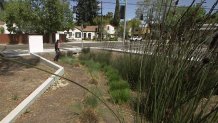You could easily pass the triangle of landscaping on San Jose's Park Street without every really noticing -- except on closer inspection one might discover there is something unusual about the sunken garden.
The corner is one of several "rain gardens" installed along the street. Its purpose is not only to add a swath of urban greenery, but to catch and cleanse storm water on its way to the bay. The soil, plants and rocks filter the water of much of its pollutants before it enters the storm drain.
"The idea behind urban greening installations like this is converting the landscape from gray to green," said Allison Chan of the environmental group Save the Bay. "Less concrete and asphalt, more reliance on nature-based infrastructure."
Save the Bay has been a vocal proponent of urban greening projects like rain gardens, since nearly every drop of rain will eventually flow to the bay. It becomes even more of an issue following long dry periods, when a "first flush" of rain will wash large amounts of surface chemicals such as motor oil into storm drains.
"By having these kinds of urban greening projects all over," Chan said, "we can really reap the climate adaptation and pollution benefits that they offer."
As communities prepare and adapt to changing climate, Chan said urban greening will play an even more vital role among the asphalt and concrete of cities. Trees and plants are known to lower temperatures and pull carbon out of the atmosphere while also offering shade.
Chan said if projects aren't as functional as rain gardens, urban greening has benefits for neighborhoods.
In East San Jose, in the working-class Tropicana-Lanai neighborhood, residents like Victoria Partida have long urged the city to install a badly needed park. Partida, who is on the neighborhood association, identified an empty lot -- often used for illegal dumping -- as a prime candidate.

Get a weekly recap of the latest San Francisco Bay Area housing news. >Sign up for NBC Bay Area’s Housing Deconstructed newsletter.
After years of neighborhood campaigning, the city has gotten on board with the project and plans to soon convert the lot into a park, including a children's playground, a gathering area and open space.
"We don’t have any parks, we don’t have open spaces," Partida said. "This’ll be our first park, our first gathering space for the whole community of ten thousand residences."
Chan said Save the Bay is urging the city to create more urban greening projects in challenged communities like in East San Jose - even taking up a petition to spur city officials to fund more greening projects.
"So we really want to see the city invest in an equitable way," Chan said, "to create the rain gardens that we see in other parts of the cities right here in East San Jose and neighborhoods just like this."
Cities like Oakland, San Mateo and Berkeley have also installed urban greening projects similar to those in San Jose. Chan said while the rain gardens are beneficial, every project that brings more green to a community is welcome.
"Any kind of project that reduces the amount of concrete and asphalt and replaces it with dirt and plants is going to have benefits for the bay," Chan said, "benefits for the surrounding community and benefits for its residents."




